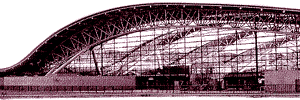Let me remind you of the three questions
I posed at the beginning:
1] why does air travel makes you feel so strange?
2] how might design improve the experience?
3] why go in person, when you can call?
I have focused on media artists in relation to question two because
architecture and design by themselves lack the motivation and the tools to
improve our experience of airport space. I suggested that different specialties
like cartography or media art might add a new dimension to the articulation of
these spaces.
 I'm not completely naive, however: it's highly unlikely that airports and their
design can be influenced in such interesting ways, especially by artists. Some
enlightened airport operators do try to make their facilities cleaner, easier
to use, and more humane. Schiphol exemplifies this. Sometimes they even hang
art on walls, or put sculptures in the concourses. But this is not really the
point. The fundamental logic of airports - their basic "operating software" -
is to process passengers, not enlighten them. As one manager said to me: "we're
an airport, not an art gallery, and not a school." Even Schiphol suffers
gravely from the fact that no one person, no one team, is responsible for the
perceptual integrity of the airport as a whole.
I'm not completely naive, however: it's highly unlikely that airports and their
design can be influenced in such interesting ways, especially by artists. Some
enlightened airport operators do try to make their facilities cleaner, easier
to use, and more humane. Schiphol exemplifies this. Sometimes they even hang
art on walls, or put sculptures in the concourses. But this is not really the
point. The fundamental logic of airports - their basic "operating software" -
is to process passengers, not enlighten them. As one manager said to me: "we're
an airport, not an art gallery, and not a school." Even Schiphol suffers
gravely from the fact that no one person, no one team, is responsible for the
perceptual integrity of the airport as a whole.
But there is another, quite different reason why my contemplation of radical
design scenarios for airports runs out of steam. Aviation is already far too
greedy a consumer of energy. Given current population trends, if we are serious
about striving toward a sustainable world economy we have to increase energy
efficiency on this planet by a factor of 20. Small, incremental improvements
each year will not be enough. In this rather daunting context, there is simply
no way our world can afford the continued mad growth of aviation.
Matter is more expensive than energy; energy is more expensive than
information. It is almost infinitely cheaper to move information than people or
things. If we are serious about a sustainable economy then - Q.E.D. - aviation
will have to contract. Radically.
It is from this rather simple if implausible proposition that we come to my
third and final point: the telematic alternative. Rather than try to "cure" the
alienating effects of airports (for example, by radical artistic intervention
into airport space) should we not be looking for alternative ways to achieve
the same ends as air travel without the obscene consumption of energy we know
aviation entails? Hence my third question: why go in person when you can call?
Why not use the phone instead? Why can't the infobahnen be a viable alternative
to KLM?
Despite all the hoopla about highways of the mind, the capacity of the
technology to recreate what it's like to be in a meeting with people somewhere
else is a long way off. A lot of the high-tech demonstrations you see or hear
about are either faked or cost $10,000 an hour. Also, a lot of the tests one
reads about involve people in one laboratory using exotic technologies to
communicate from one room to another. Hardly a global test.
But unless you've just spent a billion dollars buying a cable franchise,
whether or not the technology will eventually work is not the main point.
Existing forms of communication [EAR] already deliver perfectly satisfactory
results to billions of people everyday. POTS they call it in the trade, for
"Plain Old Telephone Service." And you don't get phone-lag. Sure, you sometimes
get unwelcome calls: but that's the result of the message, not the medium.
 If the aim of air travel were simply to exchange information, then we wouldn't
bother doing it. But exchanging information is not why we fly. It's that
mind-body business again: experientially, there never will be an alternative to
actually being there. Now I know that, and you know that, but the world's
telecommunications companies don't appear to know that. On the contrary,
they're spending vast amounts of money searching for systems and networks that
will reproduce as closely as possible the sensation of "Being There."
If the aim of air travel were simply to exchange information, then we wouldn't
bother doing it. But exchanging information is not why we fly. It's that
mind-body business again: experientially, there never will be an alternative to
actually being there. Now I know that, and you know that, but the world's
telecommunications companies don't appear to know that. On the contrary,
they're spending vast amounts of money searching for systems and networks that
will reproduce as closely as possible the sensation of "Being There."
Skip Ishii, a researcher at Japan's NTT, is a leading critic of Being
There-ness as the strategic aim of TelCos. Ishii points out that the human eye
has something like 40 million receptors in it. Many millions more receptors are
to be found in our ears, up out noses, in our skin and on our tongues. There
are dense clusters of receptors elsewhere on the body, too. Even if you could
capture the smells, sounds, tastes, and feel of a place, digitize them, and
send them down a wire, you'd still never get near the sensation of Being There.
Why? Because we humans are not so dumb. Our minds and out bodies are one
intelligence. We'd just know, that's why.
So why bother trying? Well, there's big business in all this, for one thing.
Current predictions suggest that two billion people will be flying annually by
2005, and that 20% of that number will be traveling on business. That's 400
million business travelers who might be persuaded - or told by their boss - to
take the superhighway of the mind instead of flying. As a matter of fact, this
is already happening, but not for the reasons the TelCos imagine. On the
contrary. We are witnessing a geometric explosion in InterNet use despite the
fact that the 'Net is actually rather difficult to negotiate, and is many years
away from 'Being There' verisimilitude. Most of it is boring old text. Of
course, visual trickery will come; we already have pretty realistic computer
graphics and real-time simulators. But oddly enough, the prospect of virtual
reality is not the thing turning on one million new InterNet subscribers a
month. Simulation per se has already lost its allure.
No. What drives the explosion in InterNet use is something else -- a new
quality to existing communication, the quality of connectivity.
- 
 +
+
 I'm not completely naive, however: it's highly unlikely that airports and their
design can be influenced in such interesting ways, especially by artists. Some
enlightened airport operators do try to make their facilities cleaner, easier
to use, and more humane. Schiphol exemplifies this. Sometimes they even hang
art on walls, or put sculptures in the concourses. But this is not really the
point. The fundamental logic of airports - their basic "operating software" -
is to process passengers, not enlighten them. As one manager said to me: "we're
an airport, not an art gallery, and not a school." Even Schiphol suffers
gravely from the fact that no one person, no one team, is responsible for the
perceptual integrity of the airport as a whole.
I'm not completely naive, however: it's highly unlikely that airports and their
design can be influenced in such interesting ways, especially by artists. Some
enlightened airport operators do try to make their facilities cleaner, easier
to use, and more humane. Schiphol exemplifies this. Sometimes they even hang
art on walls, or put sculptures in the concourses. But this is not really the
point. The fundamental logic of airports - their basic "operating software" -
is to process passengers, not enlighten them. As one manager said to me: "we're
an airport, not an art gallery, and not a school." Even Schiphol suffers
gravely from the fact that no one person, no one team, is responsible for the
perceptual integrity of the airport as a whole.
 If the aim of air travel were simply to exchange information, then we wouldn't
bother doing it. But exchanging information is not why we fly. It's that
mind-body business again: experientially, there never will be an alternative to
actually being there. Now I know that, and you know that, but the world's
telecommunications companies don't appear to know that. On the contrary,
they're spending vast amounts of money searching for systems and networks that
will reproduce as closely as possible the sensation of "Being There."
If the aim of air travel were simply to exchange information, then we wouldn't
bother doing it. But exchanging information is not why we fly. It's that
mind-body business again: experientially, there never will be an alternative to
actually being there. Now I know that, and you know that, but the world's
telecommunications companies don't appear to know that. On the contrary,
they're spending vast amounts of money searching for systems and networks that
will reproduce as closely as possible the sensation of "Being There."

 +
+